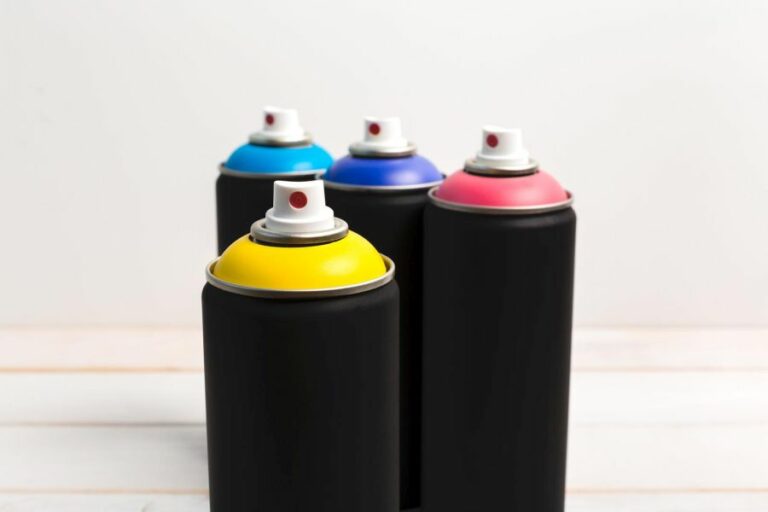Clean And Store Spray Paint Cans Correctly. What Pros Say
Storing spray paint cans correctly is crucial for maintaining the quality and safety of your paint supplies. We’ve got you covered! With easy-to-follow instructions, we can help you clean your spray paint cans and store them correctly. So, let’s dive into the proper methods for ensuring the longevity and effectiveness of your spray paint cans.
Clean & store spray paint cans correctly:
To clean and store spray paint cans, first clear and clean the nozzle by turning the can upside down and pressing it until clear gas comes out; if still clogged, soak the nozzle in paint thinner or mineral spirits. Store cans upright in a cool, dry place between 50°F and 80°F (10°C and 27°C), away from heat sources and direct sunlight. Label cans with purchase date and color description, and periodically check for damage.

Unlock the full potential of your spray paint cans by learning how to clean and store them correctly. Extend their life span, prevent clogs, and avoid frustrating mishaps. Dive deeper with us to become a spray paint pro! Keep reading for all our essential tips and tricks.
Contents
Proper Storage and Cleaning Techniques for Spray Paint Cans
Spray paint is a versatile and valuable tool for any DIY enthusiast or professional painter. However, knowing how to clean and store spray paint cans correctly is essential for preserving their quality and ensuring that they stay in proper working condition.
• Cleaning Spray Paint Cans
After using spray paint, it is important to clean the nozzle and valve system to prevent clogging and ensure smooth operation the next time you use it. Follow these simple steps to clean your spray paint cans:
– Step 1: Clear the Nozzle
Immediately after you have finished painting, turn the can upside down and press the nozzle until only clear gas comes out. This process helps to clear the nozzle of any remaining paint and reduce the risk of clogging.
– Step 2: Clean the Nozzle
If the nozzle is still clogged after clearing it, remove it from the can and soak it in some paint thinner or mineral spirits for a few hours. This will help to dissolve any remaining paint residue.
– Step 3: Rinse and Dry
After soaking the nozzle, rinse it thoroughly with water, and then dry it with a clean cloth or paper towel. Ensure that it is completely dry before reattaching it to the spray paint can.
• Storing Spray Paint Cans
Proper storage of spray paint cans is essential in preserving their quality and ensuring that they remain in good working order. Follow these guidelines to store your spray paint cans correctly:
– Store in a Cool, Dry Place
Keep your spray paint cans in a cool, dry place, away from direct sunlight or extreme temperatures. Exposure to high heat or freezing temperatures can cause the paint inside the can to deteriorate or the can to rupture. The ideal storage temperature is between 50°F and 80°F (10°C and 27°C).
– Store Upright
Always store your spray paint cans in an upright position, with the nozzle pointing up. This prevents any leakage or damage to the valve system and keeps the paint in optimal condition.
– Keep Away from Heat Sources
Store your spray paint cans away from heat sources, such as furnaces, water heaters, or radiators. Heat can cause the pressure inside the can to increase, potentially leading to an explosion.
– Label Cans
Label your spray paint cans with the date of purchase and a description of the color or project they were used for. This will make it easier to identify the right color when you need it and help you keep track of how old your spray paint cans are.
• Maintain Spray Paint Cans
Regular maintenance of your spray paint cans is crucial for ensuring that they stay in good working order. Here are some tips for maintaining your spray paint cans:
– Check for Damage
Inspect your spray paint cans regularly for any signs of damage, such as dents or rust. Damaged cans can compromise the integrity of the paint and may pose a safety risk.
– Test the Spray
Before using a spray paint can that has been stored for a while, test the spray on a piece of scrap material to ensure that it is still in good working condition. This will help you identify any potential issues, such as clogging or poor paint quality before you start your project.
– Dispose of Old or Damaged Cans Properly
If a spray paint can is damaged, severely rusted, or past its expiration date, it should be disposed of properly. Consult your local hazardous waste disposal facility to learn how to safely and legally dispose of unwanted or damaged spray paint cans.
In conclusion, cleaning and storing your spray paint cans correctly is essential to maintain their quality and ensure that they remain in proper working condition.
By following these simple steps and guidelines, you can effectively prolong the lifespan of your spray paint cans and guarantee successful painting projects in the future.







